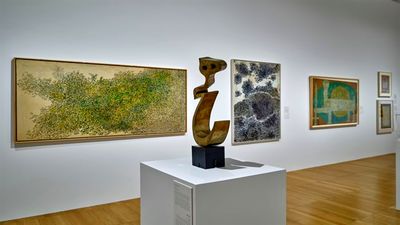The NYU Abu Dhabi Art Gallery will reopen its doors to the public on Monday, November 15, with the exhibition Modernisms: Iranian, Turkish, and Indian Highlights from NYU’s Abby Weed Grey Collection. This will be the first physical exhibition in the gallery since it moved to virtual programs in Spring of 2020.
Abby Weed Grey was a North American collector who made multiple trips abroad in the 1960s and early 1970s, to explore and collect modern art from across Asia. She made eight trips to Iran, and four trips each to India and Turkey, where she acquired the prints, drawings, paintings, and sculpture that came to form the nucleus of the Abby Weed Grey Collection of Modern Asian and Middle Eastern art, housed at New York University’s Grey Art Gallery.
The exhibition sheds new light on famed artists such as Parviz Tanavoli, Fahrelnissa Zeid , and M.F. Husain , and also includes the collector’s personal letters, journals, invoices, catalogues, invitations, and photographs from the Abby Weed Grey Papers in the NYU Archives. The archives make visible how these artists drew on their specific heritages while also engaging in global discourses around key issues of modernity.
Essays in the accompanying book allow the viewer to understand how artists of various nationalities melded local traditions with global trends of the rapidly changing modern world of the 1960s. The collection thereby contributes to ongoing dialogues that help expand the canons of modern art beyond the traditional areas of North America and Europe.
Maya Allison, chief curator at NYU Abu Dhabi, said she was delighted to welcome the local community to visit “an exhibition of such historical significance and regional relevance.”
The Grey Art Gallery has the largest institutional holdings of modern Iranian art outside Iran; the largest known institutional collection of modern Turkish art outside Turkey; and some 80 works of modern Indian art. The collection of Abby Weed Grey comprises some of the most important modern artists from that period and those regions. She embarked on her mission to collect contemporary art by non-Western artists in 1960, which resulted in a collection, the importance of which has become clear as scholarship around these artists grows.

